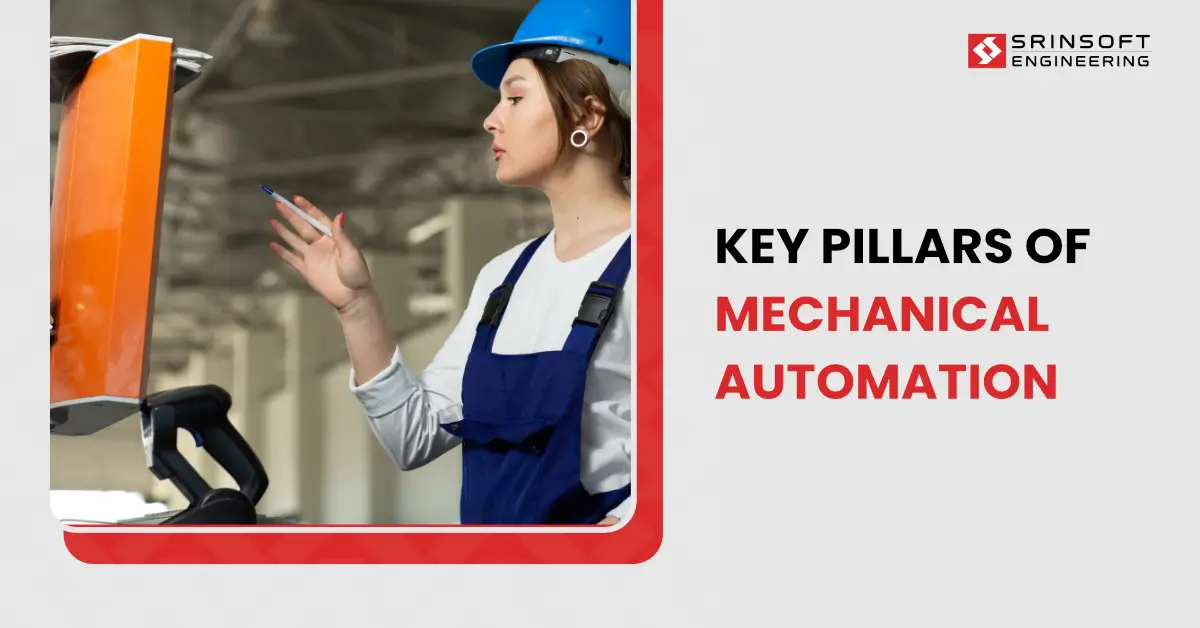
Mechanical automation encompasses a range of processes aimed at streamlining and enhancing various aspects of mechanical engineering.
By integrating design, drafting/documentation, and QA automation into their processes, mechanical engineers can significantly improve efficiency, accuracy, and the overall quality of their products.
This not only accelerates project timelines but also enhances the competitiveness of companies in the field of mechanical engineering.
Top 3 Foundational Pillar Mechanical Engineering –
1. Design Automation
Mechanical automation encompasses a range of processes aimed at streamlining and enhancing various aspects of mechanical engineering.
By integrating design, drafting/documentation, and QA automation into their processes, mechanical engineers can significantly improve efficiency, accuracy, and the overall quality of their products.
This not only accelerates project timelines but also enhances the competitiveness of companies in the field of mechanical engineering.
Here are three key facets of mechanical automation:
Design automation involves the use of software tools and algorithms to expedite the product design process.
It enables engineers to generate and evaluate design alternatives rapidly. Parameters, constraints, and rules are defined within the software, allowing for the automatic creation of designs based on specified criteria.
This not only accelerates the design phase but also ensures consistency and adherence to predefined standards.
Design automation holds a central and indispensable role in contemporary product development for various compelling reasons-
Benefits of Design Automation in Product Development
✅ Efficiency and Speed
By automating repetitive design tasks, engineers can significantly expedite the product development cycle.
This leads to faster time-to-market, a critical factor in today’s competitive business landscape.
✅ Increased Productivity
With design automation, engineers are liberated from routine, time-consuming tasks.
This allows them to concentrate their expertise on more intricate and innovative aspects of design.
As a result, productivity surges, leading to the potential for more groundbreaking and refined product designs.
✅Error Reduction
Automation mitigates the likelihood of human error in the design process.
By adhering strictly to predefined rules and parameters, designs are meticulously crafted to meet specified criteria and align with established standards. This minimizes costly and time-consuming revisions.
✅ Complexity Handling
Design automation excels in managing complex design parameters and constraints.
In situations where manual execution might be impractical or prone to oversight, automation steps in with precision and consistency.
2. Drafting/Documentation Automation
Drafting and documentation automation involves the automatic generation of technical drawings, blueprints, and other documentation required for manufacturing or construction.
By integrating design software with drafting tools, engineers can swiftly produce accurate and standardized documentation.
This reduces manual effort, minimizes errors, and ensures that all necessary details are included in the technical drawings.
Key Advantages of Drafting/Documentation Automation
✅ Efficient Creation of Technical Drawings
Automation tools expedite the process of creating technical drawings. By automatically generating views, annotations, and dimensions based on 3D models, engineers save valuable time and resources.
✅ Reduction of Errors and Omissions
Automation minimizes the potential for human error in drafting. With predefined rules and parameters, the likelihood of missing critical details or inaccuracies in technical drawings is significantly reduced.
✅ Standardization of Documentation
Automation enforces consistent standards across all technical documentation. This ensures that drawings follow established formats, styles, and conventions, leading to a unified and professional presentation.
✅ Customization for Specific Requirements
Automation tools can be tailored to specific project needs. This allows for the incorporation of project-specific details, templates, and standards, ensuring that documentation aligns precisely with project requirements.
✅ Improved Collaboration and Communication
Automated drafting tools provide a centralized platform for project stakeholders to access and contribute to technical documentation. This fosters better communication, coordination, and collaboration among team members.
✅ Quick Updates and Revisions
When design changes occur, automation enables swift updates to technical drawings. With automated revision tracking, engineers can efficiently manage and communicate changes to the entire project team.
✅ Compliance with Industry Standards
Automation tools can be programmed to ensure that technical drawings adhere to industry-specific standards and regulations. This helps in avoiding costly compliance issues and ensures that projects meet legal and safety standards.
✅ Optimization of Resources
Automation streamlines the drafting process, allowing engineers to allocate their time and expertise to more complex and critical aspects of the project. This leads to optimized resource allocation and improved overall project efficiency.
✅ Increased Productivity and Throughput
With automation handling routine drafting tasks, engineers can focus on higher-level design decisions and problem-solving. This translates to increased productivity and the potential for higher project throughput.
✅ Archival and Retrieval Efficiency
Automated documentation systems facilitate efficient storage, retrieval, and archival of technical drawings. This ensures that accurate records are maintained for future reference, audits, and compliance purposes.
3. QA Automation (Quality Assurance)
QA automation in mechanical engineering focuses on automating testing and validation processes.
This involves the use of specialized software and tools to conduct a battery of tests on prototypes or finished products.
These tests can encompass factors such as structural integrity, performance under stress, and compliance with industry standards.
Automation ensures that tests are conducted consistently and objectively, leading to more reliable quality assessments.
Benefits of Implementing QA Automation
✅ Consistent and Objective Testing
QA automation conducts tests with precision and consistency, eliminating the variability that may occur with manual testing. This ensures that each test is executed in the same manner, providing more reliable and repeatable results.
✅ Faster and More Comprehensive Assessments
Automation allows for the rapid execution of a wide range of tests, covering different aspects of product functionality. This accelerated testing process leads to quicker feedback on product quality, enabling timely adjustments and enhancements.
✅ Enhanced Product Reliability
Automated tests thoroughly evaluate product functionality and performance. By identifying and addressing issues early in the development process, QA automation contributes to a more robust and reliable final product.
✅ Regression Testing Efficiency
Regression testing, which verifies that recent code changes haven’t adversely affected existing functionalities, is a critical aspect of QA. Automation excels in this area by swiftly executing a suite of regression tests, saving time and effort compared to manual testing.
✅ Scalability and Reusability
Automated tests can be easily scaled to accommodate larger and more complex projects. Additionally, once created, test scripts can be reused across different versions of the product or in similar projects, maximizing efficiency.
✅ Resource Optimization
Automation reduces the need for manual intervention in testing processes. This allows QA teams to allocate their time and expertise to more complex and strategic testing tasks, leading to a more efficient use of resources.
✅ Early Detection of Defects
Automated tests can be integrated into the continuous integration/continuous deployment (CI/CD) pipeline, allowing for immediate testing of code changes. This early detection of defects enables teams to rectify issues before they escalate.
Increased Test Coverage
Automation enables a broader range of test scenarios to be covered, including edge cases and rare conditions that may be impractical to test manually. This leads to a more comprehensive evaluation of product functionality.
Compliance and Regulatory Adherence
Automated tests can be designed to verify that products adhere to industry-specific standards, regulations, and compliance requirements. This is especially crucial in industries with strict quality and safety standards.
Cost Savings in the Long Run
While initial setup and implementation may require an investment, QA automation ultimately leads to cost savings over time. The efficiency and thoroughness of automated testing reduce the likelihood of costly defects in the final product.


